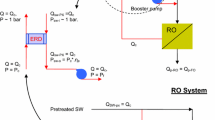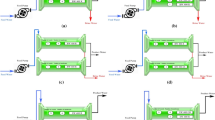Abstract
In this paper, the effects of different designs of pressure vessels on hydrodynamic parameters and the performance of seawater RO systems are investigated using computer simulations. Simulation results showed that designs using pressure vessels with four membranes in two-pass RO systems have a lower energy consumption, 5.29 and 0.33 kWh/m3 for the first and second passes, respectively, than those with two or three membranes. Also, designs No. 4 and No. 10 were the most efficient, 41 and 56% for the first and second passes, respectively, compared to other ones. The first and second passes required a lower permeate and feed pressure when using designs No. 3, No. 6, No. 9, and No. 12 where pressure vessels with two membranes were used. In addition, hybrid designs of two-pass RO systems were found to have the best efficiency and the lowest energy consumption among various other designs. Findings showed that in two-pass RO systems, the first pass consumes more energy than the second pass. Thus, the efficiency of the second pass in all designs of two-pass RO systems is more than the first pass. The results presented in this paper can be used to optimize the design of two-pass RO systems to ensure the optimum operation of such systems.









Similar content being viewed by others
Abbreviations
- BWRO:
-
Brackish water reverse osmosis
- ED:
-
Electrodialysis
- ERD:
-
Energy recovery device
- FO:
-
Forward osmosis
- GFD:
-
Gallons per square foot per day
- GPM:
-
Gallons per minute
- MSF:
-
Multi-stage flash distillation
- MED:
-
Multi-effect distillation
- NDP:
-
Net driving pressure
- RO:
-
Reverse osmosis
- SEC:
-
Specific energy consumption
- SWRO:
-
Seawater reverse osmosis
- TDS:
-
Total dissolved solids
- VC:
-
Vapor compression
References
McGinnis, R.L.; Elimelech, M.: Global challenges in energy and water supply: the promise of engineered osmosis. Environ. Sci. Technol. 42(23), 8625–8629 (2008). https://doi.org/10.1021/es800812m
Altaee, A.: Computational model for estimating reverse osmosis system design and performance: part-one binary feed solution. Desalination 291, 101–105 (2012)
Zaidi, S.J.; Fadhillah, F.; Khan, Z.; Ismail, A.: Salt and water transport in reverse osmosis thin film composite seawater desalination membranes. Desalination 368, 202–213 (2015)
Chen, J.; Li, G.: Marine reverse osmosis desalination plant—a case study. Desalination 174(3), 299–303 (2005)
Sayyaadi, H.; Saffari, A.: Thermoeconomic optimization of multi effect distillation desalination systems. Appl. Energy 87(4), 1122–1133 (2010)
Lee, K.P.; Arnot, T.C.; Mattia, D.: A review of reverse osmosis membrane materials for desalination—development to date and future potential. J. Membr. Sci. 370(1–2), 1–22 (2011)
Schiffler, M.: Perspectives and challenges for desalination in the 21st century. Desalination 165, 1–9 (2004)
Park, K.; Kim, J.; Ryook, Y.D.; Hong, S.: Towards a low-energy seawater reverse osmosis desalination plant: a review and theoretical analysis for future directions. J. Membr. Sci. 595, 117607 (2020)
Alabduljalil, S.; Alotaibi, S.; Abdulrahim, H.: Techno-economic evaluation of different seawater reverse osmosis configurations for efficient boron removal. Desalin. Water Treat. 168, 65–76 (2019)
Altaee, A.; Zaragoza, G.; van Tonningen, H.R.: Comparison between forward osmosis-reverse osmosis and reverse osmosis processes for seawater desalination. Desalination 336, 50–57 (2014)
M. A. Mustaqimah; M. Alghoul; P. Poovanaesvaran; A. M. F. F. Annisa; K. Sopian (2013) “Comparison of one stage and two stage-brackish water reverse osmosis system: a simulation study”, Comput. Methods Sci. Eng.
Joseph, A.; Damodaran, V.: Dynamic simulation of the reverse osmosis process for seawater using LabVIEW and an analysis of the process performance. Comput. Chem. Eng. 121, 294–305 (2019)
Al-Obaidi, M.A.; Alsarayreh, A.A.; Al-Hroub, A.M.; Alsadaie, S.; Mujtaba, I.M.: Performance analysis of a medium-sized industrial reverse osmosis brackish water desalination plant. Desalination 443, 272–284 (2018)
Pearson, J.L.; Michael, P.R.; Ghaffour, N.; Missimer, T.M.: Economics and energy consumption of brackish water reverse osmosis desalination: innovations and impacts of feedwater quality. Membranes (Basel) 11(8), 616 (2021). https://doi.org/10.3390/membranes11080616
Oh, H.-J.; Hwang, T.-M.; Lee, S.: A simplified simulation model of RO systems for seawater desalination. Desalination 238(1–3), 128–139 (2009)
Wilf, M.; Klinko, K.: Optimization of seawater RO systems design. Desalination 138(1–3), 299–306 (2001)
Ghourejili, S.; Vahidfard, V.; Mousavi, Y.; Babapoor, A.; Faraji, M.: Effect of temperature on energy consumption and recovery rate of the reverse osmosis brackish systems in a different arrangement. Sci. Iran. 29(6), 3167–3178 (2022)
Fritzmann, C.; Löwenberg, J.; Wintgens, T.; Melin, T.: State-of-the-art of reverse osmosis desalination. Desalination 216(1–3), 1–76 (2007)
Hamed, O.A.: Overview of hybrid desalination systems—current status and future prospects. Desalination 186(1–3), 207–214 (2005)
Solutions, D.W.: Filmtec™ reverse osmosis membranes. Tech. Man. Form 399(609–00071), 1–180 (2010)
Gullinkala, T.; Digman, B.; Gorey, C.; Hausman, R.; Escobar, I.C.: Desalination: reverse osmosis and membrane distillation. Sustain. Sci. Eng. 2, 65–93 (2010)
Altaee, A.: Theoretical study on feed water designs to reverse osmosis pressure vessel. Desalination 326, 1–9 (2013)
Hoek, E.M.; Allred, J.; Knoell, T.; Jeong, B.-H.: Modeling the effects of fouling on full-scale reverse osmosis processes. J. Membr. Sci. 314(1–2), 33–49 (2008)
Kim, J.; Hong, S.: A novel single-pass reverse osmosis configuration for high-purity water production and low energy consumption in seawater desalination. Desalination 429, 142–154 (2018)
Lenntech. "Reverse osmosis demineralization." https://www.lenntech.com (accessed 2022).
Ghourejili, S.; Valizadeh Harzand, F.; Yaghoubi, S.; Babapoor, A.: Investigation of the effects of temperature on net driving pressure and pressure drop in different configurations of the reverse osmosis system using computer simulations. Arab. J. Sci. Eng. (2023). https://doi.org/10.1007/s13369-023-07841-6
Ghourejili, S.; Yaghoubi, S.; Valizadeh Harzand, F.; Mousavi, Y.; Babapoor, A.: Effects of total dissolved solids on pressure drop and net driving pressure in different designs of brackish and seawater reverse osmosis systems. Arab. J. Sci. Eng. 48(7), 8785–8799 (2023). https://doi.org/10.1007/s13369-022-07393-1
Kim, J.; Hong, S.: Optimizing seawater reverse osmosis with internally staged design to improve product water quality and energy efficiency. J. Membr. Sci. 568, 76–86 (2018)
Author information
Authors and Affiliations
Corresponding author
Rights and permissions
Springer Nature or its licensor (e.g. a society or other partner) holds exclusive rights to this article under a publishing agreement with the author(s) or other rightsholder(s); author self-archiving of the accepted manuscript version of this article is solely governed by the terms of such publishing agreement and applicable law.
About this article
Cite this article
Ghourejili, S., Yaghoubi, S., Mousavi, Y. et al. Effects of the Design of Pressure Vessels on Performance and Hydrodynamic Parameters in Two-Pass Seawater Reverse Osmosis Systems. Arab J Sci Eng 49, 8011–8020 (2024). https://doi.org/10.1007/s13369-023-08621-y
Received:
Accepted:
Published:
Issue Date:
DOI: https://doi.org/10.1007/s13369-023-08621-y




